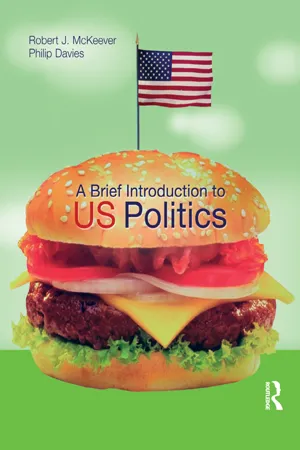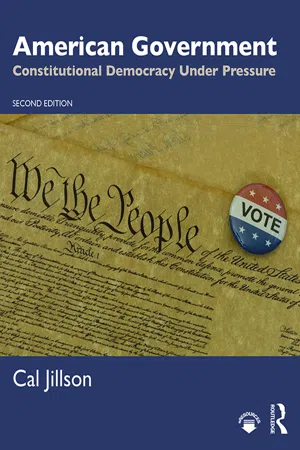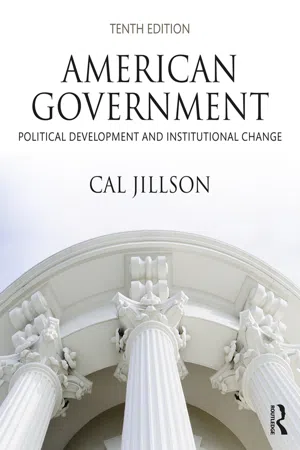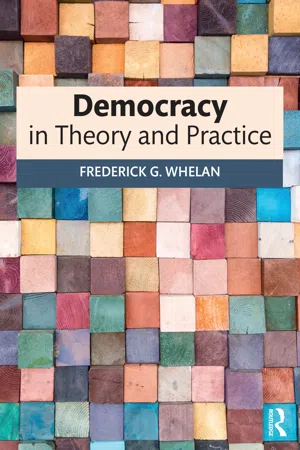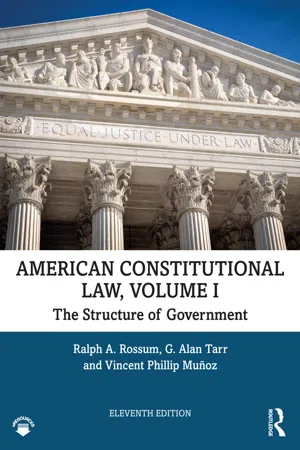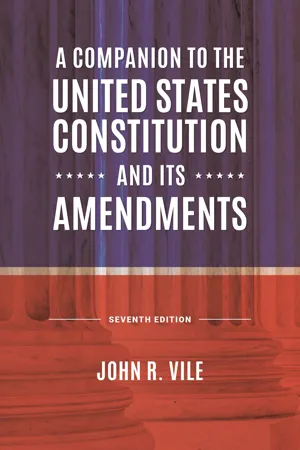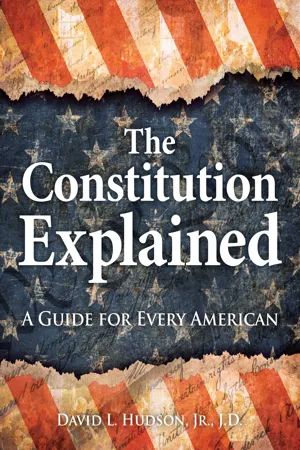Law
Executive Power US
Executive power in the US refers to the authority vested in the President to enforce and administer laws, as well as to manage the operations of the federal government. This power includes the ability to issue executive orders, appoint federal officials, and conduct foreign policy. The scope and limits of executive power are defined by the US Constitution and have been the subject of ongoing debate and legal interpretation.
Written by Perlego with AI-assistance
Related key terms
Related key terms
1 of 4
Related key terms
1 of 3
10 Key excerpts on "Executive Power US"
- eBook - ePub
- Robert J. Mckeever(Author)
- 2014(Publication Date)
- Routledge(Publisher)
Chapter 6 The presidency and the executive branchThe presidency of the United States is often referred to as the most powerful office in the world. In truth the executive is but one branch in American constitutional government, and the presidents who occupy the leading office in this branch face considerable complications in turning their executive agenda into deliverable policy. The Constitution provides the president with the tools of office, and the office-holders use these tools with differing skills, and in differing contexts. The office has certainly taken a central role in national and international perceptions of American government, and this perception itself adds to the authority that it has gained over the centuries. The president still faces a complex situation, having at all times to negotiate major initiatives with the members of the US Congress.The executive branch of the federal government includes a vast array of experts organised into departments and agencies. Their purpose is to serve the government, and especially the president, by providing specialist knowledge to policy-makers and by administering national laws and policies. The executive branch of the United States government employs almost 2.7 million men and women, that is, approximately one in fifty of all Americans in work (Statistical Abstract of the United States, 2004–5). This is a remarkable number of government employees for a nation which prides itself on its individualism and its belief in limited government. Nevertheless, the phenomenal growth in the size and range of the federal bureaucracy is no aberration. Rather, it has been a logical response to the increasing complexity of American society and the unrelenting growth in federal government responsibilities.The constitutional debateThe members of the US Constitutional Convention debated long and hard about the form that the nation’s executive should take. There was little enthusiasm for a system that might replace George III with a home-grown executive that might prove equally threatening, but there were concerns that the new nation should have an executive leadership capable of acting decisively in the nation’s interest when necessary. Thomas Cronin (1989) points out that at least sixty votes were taken by the authors of the US Constitution on the method of election of the executive, eligibility to hold the office, and the length and number of terms of office. - eBook - ePub
American Government
Constitutional Democracy Under Pressure
- Cal Jillson(Author)
- 2020(Publication Date)
- Routledge(Publisher)
Chapter 9The Executive Branch
The President, the Bureaucracy, and Executive Power
Focus Questions and Learning GoalsQ1 How did the Founders limit the powers that they placed with the president?Q2 What forces account for the growth of executive power over the course of American political history?Q3 Why does the president have an easier time in shaping and implementing foreign policy than he does domestic policy?Q4 How does the president relate to the executive branch?Q5 Should we be concerned that White House staff members have replaced members of the cabinet as the president’s closest advisers?The Unitary Executive Theory of Presidential Authority
Article II, section 1: “The executive power shall be vested in a President of the United States of America.”While the constitutional origins of presidential authority are clear, centering on the clause above, the scope and limits of that authority are hotly contested. Scholars have long noted that while the powers explicitly enumerated in the Constitution’s Article II are few—commander in chief, pardon power, and, with the advice and consent of the Senate, broad appointment powers—the president has additional unenumerated powers.unitary executive theory Strong presidency theory holding that the president embodies executive authority and is the sole judge, particularly in wartime, of what is required to protect the nation and its people.Moreover, students of executive power all the way back to John Locke (1632–1704) have argued that kings and presidents may have to act outside the law or even in contravention of the law when great dangers threaten. The “inherent powers” of the executive, they argue, may require bold action, even action that would be illegal under normal circumstances, to confront dire threats. Officials of the George W. Bush administration argued for an even broader “unitary executive” theory of presidential authority. The unitary executive theory - eBook - ePub
American Government
Political Development and Institutional Change
- Cal Jillson(Author)
- 2019(Publication Date)
- Routledge(Publisher)
Presidents throughout the nineteenth century, with the significant exceptions of Polk and Lincoln, were scrupulous in their adherence to the maxim that the application of force requires prior approval by the Congress except in response to attack. As we shall see below, twentieth-century presidents have taken a different view.treaty-making power Article II, section 2, of the Constitution gives the president, with the advice and consent of the Senate, the power to make treaties with foreign nations.executive agreements Agreements negotiated between the president and foreign governments. Executive agreements have the same legal force as treaties but do not require confirmation by the Senate.Constitutional LimitationsPresidents at least since Jefferson have pointed to the separation of powers theory to maintain and justify their autonomy and independent authority. In fact, Jefferson argued that presidents have just as much right and authority to interpret the Constitution, especially in regard to presidential powers, as the courts do. Chief Justice John Marshall disagreed and said so authoritatively in the landmark case of Marbury v. Madison (1803). Nonetheless, presidents continue to argue that their powers should be construed broadly.Beginning with Eisenhower, but more formally with Nixon, presidents have claimed and the Supreme Court has recognized a sphere of executive privilege —the rights of presidents and their advisers to maintain the confidentiality of their conversations and communications. But the Founders blurred separation of powers to assure adequate checks and balances by giving each branch a role in the other branch’s activities. Hence, when Congress calls for information from the executive in pursuit of its oversight responsibilities and the president responds by citing executive privilege, the stage is set for protracted negotiations or legal arguments, often both.executive privilege The right of presidents, recognized by the Supreme Court, to keep conversations and communications with their advisers confidential.Congress and the Courts. - eBook - ePub
- Frederick G. Whelan(Author)
- 2018(Publication Date)
- Routledge(Publisher)
14 The chief of a victorious parliamentary party who becomes prime minister holds a similar position, especially if his or her party wins a majority of seats. Hence the meaning of “executive,” especially in the case of the chief executive as a political leader, goes well beyond the meaning of the term in the classical separation-of-powers theory. In that theory, the active or directing power of the state was assumed to be vested in the legislature, which passed laws which the executive merely carried out: the job of a minister, by the same token, was merely to administer, and that of a president merely to preside over the executive apparatus. Partly because of its combination of roles, and partly because it is vested in the final analysis in a single individual, the executive power of a modern state is normally in practice its directive power, hence a suitable location for a leader to apply his distinctive skills.Foreign policy, including military and national security affairs, is one important domain where policy is largely made, not just executed, by the chief executive, aided and sometimes guided by the subordinate foreign and defense ministers and the staffs of their departments.In the original Hamiltonian conception of the executive power in the US Constitution, the emphasis was on the need for energy, decisiveness, speed, and unity in the president’s exercise of the authority of the state. These are qualities that have a special bearing on foreign affairs, where situations requiring decisions can arise rapidly and unexpectedly.(Federalist no. 70)ALEXANDER HAMILTON Box 17.1Alexander Hamilton (1755–1804) was an American revolutionary, delegate to the Constitutional Convention, principal author ofThe Federalist, and first Secretary of the Treasury. He advocated a strong national government with the federal structure and a strong or “energetic” president in the federal government. - eBook - ePub
American Constitutional Law, Volume I
The Structure of Government
- Ralph Rossum, G. Alan Tarr, Vincent Phillip Munoz(Authors)
- 2019(Publication Date)
- Routledge(Publisher)
The Federalist, No. 68, of ensuring that only figures of national stature would be elected, thereby affording “a moral certainty that the office of President will seldom fall to the lot of any man who is not in an eminent degree endowed with the requisite qualifications.”Most significantly, the Framers granted to the president extensive powers. Primary among these powers are those enumerated in Article II of the Constitution. In the legislative sphere, the president:- Must inform Congress as to the State of the Union (Section 3)
- Can recommend legislation to Congress (Section 3)
- Can call Congress into special session and, if the two houses disagree on the time of adjournment, adjourn it (Section 3)—no longer important with the advent of year-round congressional sessions
- Can veto legislation (Article I, Section 7, Paragraphs 2 and 3)
- Can appoint executive officers and fill vacancies in such offices (Section 2, Paragraphs 2 and 3)
- Can require the heads of executive departments to furnish advice, in writing, on subjects relating to the duties of their offices (Section 2, Paragraph 1)
- Must take care that the laws are faithfully executed (Section 3)
- Can grant pardons and reprieves (Section 2, Paragraph 1)
- Must take care that the laws are faithfully executed (Section 3)
- Exercise “the executive Power” vested in the President (Section 1, Paragraph 1)
- “Preserve, protect, and defend the Constitution,” as required in the presidential oath of office (Section 1, Paragraph 8)
Presidential powers, however, are not limited to those expressly listed in the Constitution. Much of the debate about the presidency has centered on how far beyond those enumerated powers presidential power extends. What emerges from the Framers’ discussions is a commitment to giving the president powers adequate to the responsibilities of the office. - John R. Vile(Author)
- 2021(Publication Date)
- Praeger(Publisher)
HAPTER 3ARTICLE II: THE EXECUTIVE BRANCHIn modern times, the U.S. president is typically the most powerful individual in the world. Although presidential power waxes and wanes with the personality of the individual who occupies the office and the circumstances of the time, much of it derives from the nature of the office itself. Just as Article I lists the powers and limits of the legislative branch of the national government, so, too, Article II describes and limits the executive branch. The opening sentences of Articles I and II differ. Whereas Article I refers to “all powers herein granted,” Article II refers less restrictively to “the executive Power.” Traditionally, executives exercised prerogative powers that gave them greater leeway than the legislature, especially during times of war and emergencies.Article II, Section 1. The executive Power shall be vested in a President of the United States of America. A Single ExecutiveSome delegates to the Constitutional Convention, including some advocates of the Virginia Plan, favored a single executive. Others, generally supporting the New Jersey Plan, wanted a plural executive. The former group prevailed, and the delegates vested the “executive Power” in a single president who, along with a vice president, serves terms of four years.Undoubtedly, the framers enlarged the power and increased what the framers called the “energy” of this office by vesting the presidency in one individual. As a single individual, the president’s words are far more important, and the president’s actions elicit far more attention, than if the president were but one member of an executive council or committee. The media give far more coverage to individual presidents than to members of Congress, with its 535 members, or the U.S. Supreme Court, with its nine.The U.S. president is both the head of state and the head of government, thus combining the real and symbolic powers that England and other constitutional monarchies divide between the prime minister and the king or queen. A president has a unique capacity for performing both good and ill. Woodrow Wilson once noted that, “The President is at liberty, both in law and conscience, to be as big a man as he can.” Certainly, presidents like George Washington, Andrew Jackson, Abraham Lincoln, Theodore and Franklin D. Roosevelt, and Ronald Reagan have validated the accuracy of Wilson’s observation. A number of these individuals have radically changed the popular image and expectations of the presidency.- eBook - ePub
American Constitutional Law 8E, 2-VOL SET
2-VOLUME SET
- Ralph A. Rossum(Author)
- 0(Publication Date)
- Routledge(Publisher)
no reasonable grounds to believe that further investigation is warranted. The decisions regarding the scope of that further investigation, its duration, and, finally, whether or not prosecution should ensue, are likewise beyond the control of the President and his subordinates. . . . If to describe this case is not to decide it, the concept of a government of separate and coordinate powers no longer has meaning. . . .Art II., § 1, cl 1 of the Constitution provides: The executive Power shall be vested in a President of the United States. . . . [T]his does not mean some of the executive power, but all of the executive power. It seems to me, therefore, that the decision of the Court of Appeals invalidating the present statute must be upheld on fundamental separation-of-powers principles if the following two questions are answered affirmatively: (1) Is the conduct of a criminal prosecution (and of an investigation to decide whether to prosecute) the exercise of purely executive power? (2) Does the statute deprive the President of the United States of exclusive control over the exercise of that power? Surprising to say, the Court appears to concede an affirmative answer to both questions, but seeks to avoid the inevitable conclusion that since the statute vests some purely executive power in a person who is not the President of the United States it is void. . . .The utter incompatibility of the Court's approach with our constitutional traditions can be made more clear, perhaps, by applying it to the powers of the other two Branches. Is it conceivable that if Congress passed a statute depriving itself of less than full and entire control over some insignificant area of legislation, we would inquire whether the matter was "so central to the functioning of the Legislative Branch" as really to require complete control, or whether the statute gives Congress "sufficient control over the surrogate legislator to ensure that Congress is able to perform its constitutionally assigned duties"? Of course we would have none of that. Once we determined that a purely legislative power was at issue we would require it to be exercised, wholly and entirely, by Congress. Or to bring the point closer to home, consider a statute giving to non-Article III judges just a tiny bit of purely judicial power in a relatively insignificant field, with substantial control, though not total control, in the courts—perhaps "clear error" review, which would be a fair judicial equivalent of the Attorney General's "for cause" removal power here. Is there any doubt that we would not pause to inquire whether the matter was "so central to the functioning of the Judicial Branch" as really to require complete control, or whether we retained "sufficient control over the matters to be decided that we are able to perform our constitutionally assigned duties"? We would say that our "constitutionally assigned duties" include complete control over all exercises of the judicial power—or, as the plurality opinion said in Northern Pipeline Construction Co. v. Marathon Pipe Line Co. (1982), that "[t]he inexorable command of [Article III] is clear and definite: The judicial power of the United States must be exercised by courts having the attributes prescribed in Art III." We should say here that the President's constitutionally assigned duties include complete - eBook - ePub
The Constitution Explained
A Guide for Every American
- David L. Hudson(Author)
- 2022(Publication Date)
- Visible Ink Press(Publisher)
Article II—The Powers of the PresidencyThe Vesting Clause
The executive Power shall be vested in a President of the United States of America.Article II examines the powers of the executive branch and does so in just about 1,000 words. Much of the language, as elsewhere in the Constitution, is written in very general terms. However, the first line refers to the fact that “the executive power shall be vested in a President of the United States of America.” This first sentence is known as the Vesting Clause. It establishes the office of the presidency. This was no foregone conclusion, as we saw with the Articles of Confederation. Furthermore, the Framers at the Philadelphia Convention actually argued over whether the executive branch should have a single leader or a council of three or more. The most common proposals put forth were a three-person presidency and a one-person presidency. The one-person presidency obviously won out.The vesting clause, at a minimum, establishes that there is a president. Some contend that this clause gives the president executive powers, which includes various implied powers that are not given explicitly in other provisions of Article II. Some scholars further argue that the Vesting Clause gives the executive a great deal of power. For example, law professor John Yoo writes in his book The Powers of War and Peace (2005) that “Article II’s Vesting Clause requires that we construe any ambiguities in the allocation of power in favor of the President.” This school of thought is associated with the term “unitary executive”—meaning that the president often has the sole authority to act in certain circumstances.The vesting clause, at a minimum, establishes that there is a president. Some contend that this clause gives the President executive powers, which includes various implied powers that are not given explicitly in other provisions of Article II. - eBook - ePub
The Constitution of Canada
A Contextual Analysis
- Jeremy Webber(Author)
- 2021(Publication Date)
- Hart Publishing(Publisher)
We began this chapter with the principle of responsible government. A similarly overarching principle governs the exercise of governmental functions: the rule of law, which requires that executive power be deployed only within a framework established by law. The rule of law is often thought to be in tension with parliamentary sovereignty, but in its application to the executive the two principles are in substantial if not total alignment. The rule of law requires that the executive stays within its legal authority, which, in a system based on parliamentary supremacy, means that it must remain within the framework determined by the legislature. This application of the rule of law also has compelling significance for human rights, for the vast majority of rights violations by states are committed by the executive, given the latter’s immediate control over the instruments of state power.A. Legal Foundations of Executive AuthorityThe executive draws its powers from three sources: (1) the ‘royal prerogative’ (the residue of the inherent executive authority originally possessed by the monarch); (2) delegation of powers from Parliament; and (3) powers it exercises by virtue of its legal personality, which are comparable to those exercised by any other legal person. The first and the third sources are sometimes run together because neither depends upon a legislative grant, but it is useful to separate the two; the prerogative consists of distinctively governmental powers enjoyed by no other legal person and potentially subject, therefore, to special restrictions. As we will see in chapter 6 , the distinction between the two underlies the best explanation for the federal ‘spending power’.The royal prerogative was once very extensive, but it has been progressively, and dramatically, limited by statute. Indeed, the seventeenth-century struggles between the English King and Parliament were largely fought over the prerogative, with the King denied authority to create new courts separate from common law or statutory courts, to create monopolies without parliamentary sanction, to levy taxes without parliamentary authority, and to dispense with or suspend the enforcement of duly enacted laws. Since that time, Parliaments in the United Kingdom and Canada have continued to scale back the prerogative and to constrain its exercise with statutory limitations and conditions. Restrictions include the replacement, in very large measure, of the prerogative to create corporations with administrative procedures governed by statute, and of the prerogative of mercy with a system of pardons (now ‘record suspensions’) administered by the Parole Board of Canada. It is generally accepted that the prerogative could be eliminated entirely if Parliament so enacted.8 - eBook - ePub
Princeton Studies in American Politics
Legislative Capacity and the Dynamics of Executive Power
- Alexander Bolton, Sharece Thrower(Authors)
- 2021(Publication Date)
- Princeton University Press(Publisher)
6Some academics, too, believe such expansions of executive power have undermined the US separation of powers system. Law professor Neal Devins, for example, calls checks and balances in the contemporary era “an abject failure.”7 Professor Peter Shane contends we are currently living in “Madison’s nightmare,” as the separation of powers system grows “increasingly battered” by the “gathering concentration of power in the hands of the federal executive” (2009, 3). Pessimism reigns regarding legislatures’ ability to redress encroaching executive power. Posner and Vermeule (2010, 14) write, “The administrative state does indeed feature an imperial executive; the critics are wrong only in thinking that anything can be done about this fact.”Fears of executive overreach likewise pervade state governments, where gubernatorial power comes under the microscope. Like presidents, governors also advance capacious views of their executive prerogatives. In 2015, New York Governor Andrew Cuomo remarked: “I am the executive and therefore I use executive power. …I have many powers beyond those which the Legislature passes …the executive, whether it’s the President, the mayor or the governor, you run the government. …And you have a whole host of powers that are apart and aside from the Legislature.”8The COVID-19 pandemic alerted many to the broad powers governors wield, as decisions to issue stay-at-home orders and mandate health requirements for businesses became subjects of national controversy. While most applauded gubernatorial actions to quell the deadly pandemic, others decried executive abuses. In a letter to the Oregon Legislature, Jackson County commissioners demanded limitations on Governor Kate Brown’s puissant emergency powers, pleading: “While this level of authority may be appropriate for a short-term state of emergency caused by a fire, earthquake, or other natural disaster, as applied to an emergency like the novel coronavirus, the Governor has essentially unchecked authority to issue orders for an unlimited amount of time which dramatically impact the lives of everyday Oregonians.”9
Index pages curate the most relevant extracts from our library of academic textbooks. They’ve been created using an in-house natural language model (NLM), each adding context and meaning to key research topics.
Explore more topic indexes
Explore more topic indexes
1 of 6
Explore more topic indexes
1 of 4
